Alocasia Sarian – Rare
Original price was: ₹1,598.00.₹949.00Current price is: ₹949.00.
44 in stock
Size: Single plant | Pot Included | Free Shipping
Alocasia Sarian is a sizable houseplant great for any indoor space. This stunning centerpiece has an airy stem and leaf structure. It has a tropical look with forest, dark green leaves, and the tiger-striped stems.
Alocasia Sarian Plant Care
Soil
For optimum growth, this plant needs light, airy, and well-draining soil. Never plant it in a heavy soil mixture as it is a rhizomatous plant. Don’t use rocky or sandy soils either.
Any organically rich soil that has great moisture retention is perfect for the Alocasia Sarian.
This plant should be planted outdoors only if the night temperature does not go below 60 degrees Fahrenheit (15°C).
Further details about temperature will be discussed later on in this article.
Watering
Check the soil regularly to make sure it’s moist at all times. During spring and summer, the plant grows actively, so it needs extra water to grow all the new leaves.
I would suggest watering in smaller amounts at regular intervals. This will maintain the desired moisture content without letting the soil get soggy.
The roots cannot tolerate wet feet or soggy soil, but don’t let the plant dry out completely.
This species is not drought-tolerant; therefore, lack of water can damage the beautiful leaves as they will curl and go crispy. Insufficient watering may even kill your Alocasia.
A simple watering schedule for this plant includes watering it twice a week in summer and once a week in winter.
I would suggest relying on the actual dampness of soil instead of a fixed schedule. Always press a few inches of topsoil with your fingers before you water and only water if dry.
This plant will go dormant in winter means it spends less energy, so reduce the watering.
Light
The most attractive part of this plant is the leaves, but the plant needs bright indirect sunlight to maintain its foliage color.
This plant prefers a balance between full sun and partial shade. Remember that this plant can burn easily in direct sun as Alocasias cannot withstand direct light at all.
Temperature
This Alocasia, similar to other varieties, is sensitive to cold. It will appreciate warm and humid indoor conditions. Temperatures ranging between 65 to 72 degrees Fahrenheit (18 to 22 degrees Celsius) are ideal for maximum, healthy growth.
This plant is slightly fussy about temperature; lower temperatures can reduce the plant growth drastically.
Whenever my Alocasia had slow growth, shifting it to a warmer spot has fixed the problem for me. You should position your plant away from draughty windows, doors as well as air conditioners.
This frost-sensitive plant cannot survive outdoors in winter; freezing temperatures will severely damage the foliage.
Move your outdoor containers indoors in autumn when the temperature starts dropping below 60 degrees Fahrenheit (15°C).
Humidity
Alocasia plants struggle at low humidity levels. At least 60 % of indoor humidity is necessary.
In a perfect world, 70% or higher would be great. Place it in a humid location like in a bathroom or kitchen. The Alocasia should not be located near radiators as they cause the soil to dry out.
Grouping plants together can also create the desired humidity. You can run a humidifier as an extra step if you want to rely on artificial methods for better humidity.
Fertilizer
Plant food helps promote new growth on the Alocasia Sarian. In spring and summer, you can feed it with an all-purpose liquid fertilizer.
If you notice more growth on the plant, you might want to increase the fertilization. When grown in warm, bright locations, the plant will have more growth; hence more nutrients are needed.
If you want a fertilizing routine that needs minimum effort, apply a slow-release fertilizer to the Alocasia plant periodically. This will ensure the soil has all the necessary nutrients throughout the growing season.
Slow-release fertilizer reduces the risk of over-fertilization because the nutrients are released in the soil slowly.
You should discontinue fertilization in late autumn and resume in the early spring months.
Repotting
You can refresh the plant-soil annually. But repotting is only necessary when the plant outgrows the pot, or there is severe damage to the rhizomes.
Do not immediately repot a newly bought plant. Let the plant acclimatize to its new environment. Immediate repotting may shock the plant.
Pruning
Pruning helps you in managing your houseplants, especially the fast-growing species like Alocasia Sarian. Within six months, this plant will develop leaves growing in all different directions hence invading the space for the neighboring plants.
You can prune a few leaves or stems and utilize them for propagation. The other time this plant needs pruning is when it is infected, or the foliage is decaying. You should trim the yellow or damaged leaves to give a fresh look to your Alocasia.
Propagation
Propagation is a great tool to multiply your plants without spending anything. Most Alocasia species are propagated via clump or rhizome division. Propagation is an excellent option for crowded plants if you don’t want to repot them.
This tuberous plant develops from a tuber or rhizome. It will additionally produce small offsets that are exact copies of the parent plant. These offsets grow from the roots at the base of the plant. They can be easily removed and planted in separate pots.
For rhizome division, carefully remove the Alocasia Sarian from its pot and brush away the excess soil around the roots. If the soil has huge clumps, do not press hard to free the roots, this will damage the roots. You can soften the clumps by spraying it with water.
The root system might look complicated because everything is interconnected, but you can easily separate the rhizomes for propagation.
Use a disinfected pair of scissors or knife to untangle the roots. These small clumps/offsets often have their own root system, so you will not have to wait for root development.
Water Propagation
- Water propagation is mostly preferred for stem cuttings, but this method is equally successful for rhizomes.
- Find a small container or jar that can host the Alocasia rhizome during the process. I use glass containers to enjoy the growth of the plant.
- Fill the container with water and let it sit for about 24 hours. This will help you remove impurities and chlorine from the water.
- Now submerge the rhizome in water and place it in a spot with bright, filtered sunlight.
- Avoiding direct sunlight exposure is highly important because it encourages algae growth.
- You can replace or add more water whenever you feel the water has evaporated or it’s getting dirty.
- You can mix a small quantity of liquid houseplant fertilizers in the water to encourage more growth.
- Once you notice new growth, shift it to the soil.
Soil Propagation
- The most commonly used rooting medium for Alocasia propagation is soil. Since the plant already has tiny roots, you can directly pot it in a new container with fresh soil.
- You can use regular nursery pots with drainage holes, fill them with an appropriate potting mixture.
- Make sure the potting mixture holds moisture well because this tropical species needs moisture to thrive. Regular potting soil with coco coir and perlite is an excellent medium for the newly propagated plant.
- Plant the rhizome in the mixture by making a small hole in the center. Place the rhizome in this hole and pour the remaining soil on it.
- Give the newly planted Alocasia a light drink to moisturize the soil and leave it in a bright location for further growth.
- Despite the existing roots, the plant may suffer from transplant shock, and it can take a few weeks for new growth.
- If the leaves start popping, congratulations, you have successfully propagated the Alocasia Sarian.
Blooms
With proper care, this plant will grow tiny spathe flowers throughout the year, but these are secondary to the decorative foliage.
The Sarian plant has unscented flowers that resemble the Calla lily. It flowers like a typical aroid with a spike-like spadix that is surrounded by a leaf-like spathe.
The flowers are white in color, but these are not showy or attractive.
Growth
This plant has a unique growing pattern similar to the domino effect. Each new leaf on the plant is split out of the stem of the last leaf.
This will create beautiful lines on the leaves that this plant is famous for. The upper side of the Sarian leaves have thick lime green veins adding to the beauty of this plant.
This tropical perennial plant, with its unique, glossy, heart-shaped leaves, has prominent white veins passing through the leaf. The thin, cylindrical stems support the large leaves that point upwards.
Leaves on the young Sarian plant are arrow-shaped with pointy and triangular tips. As the plant matures, each leaf develops distinctive marking, veining, and coloration.
The veining and coloration may increase or decrease depending on the environmental conditions.
As an indoor plant, it will get 3 to 4 ft in height, whereas the leaves can get 1 ft long in size. Outdoors, under optimum conditions, the Sarian plant will get 5 to 10 ft in height while the leaves can also get quite big.
Generally, the size will vary greatly depending on the plant’s location and environment.
Overall this is a fast-growing plant that can take over any space within few months. It grows relatively faster in summer.
Only logged in customers who have purchased this product may leave a review.

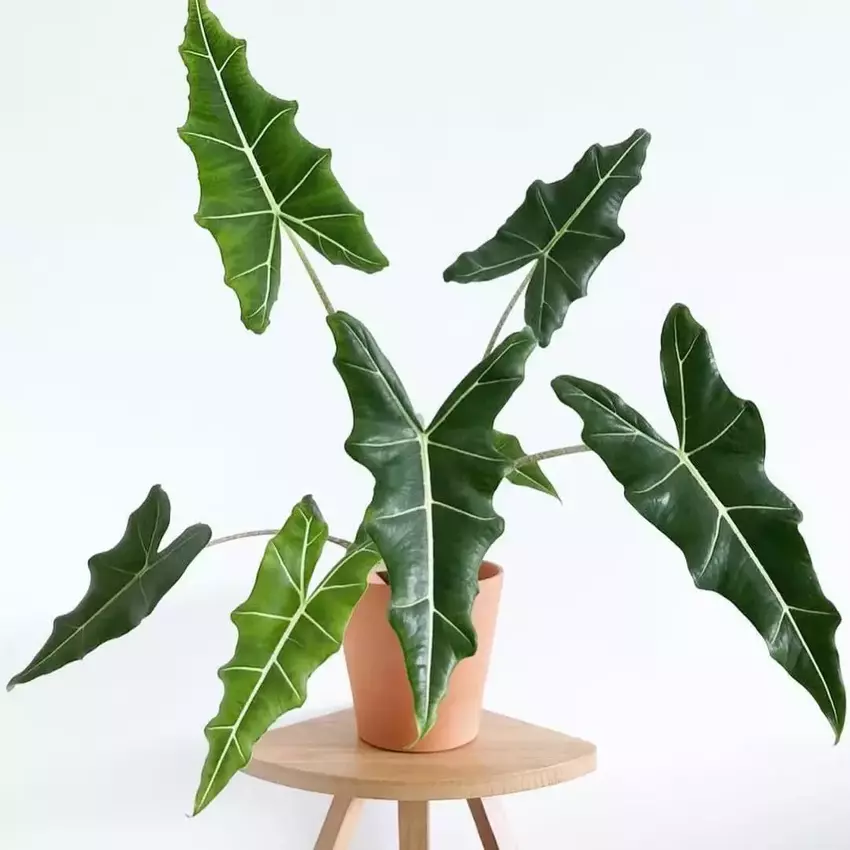
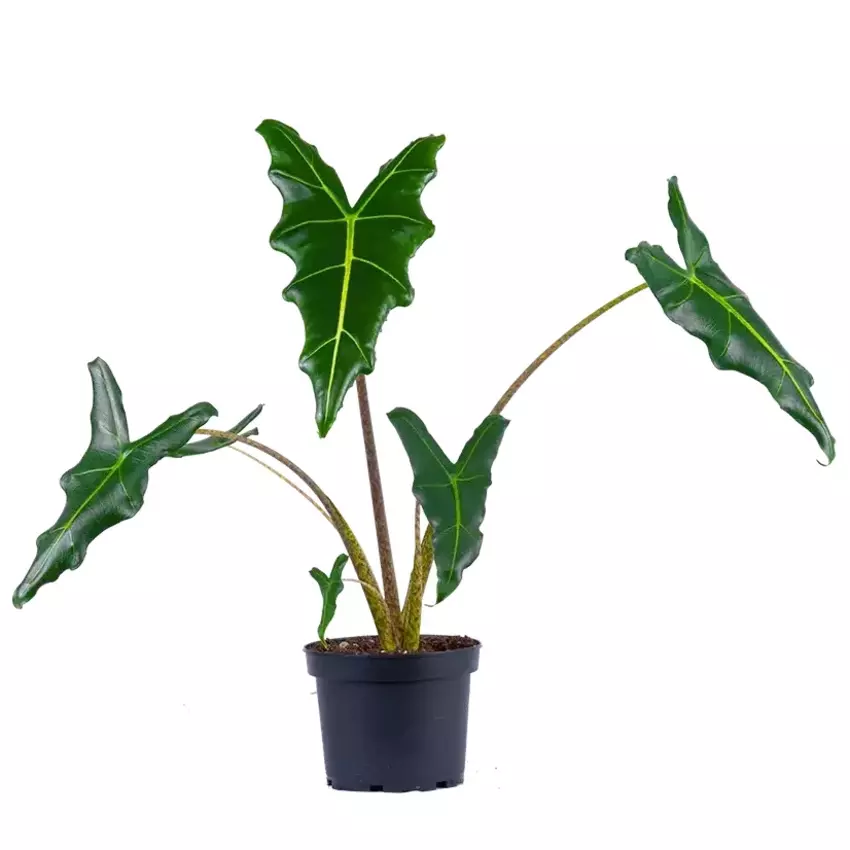
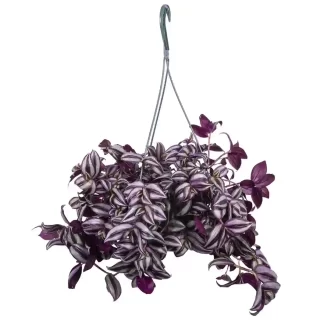
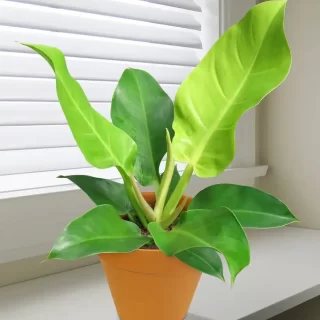
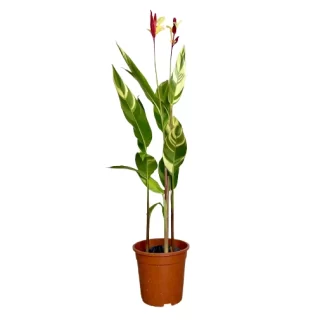
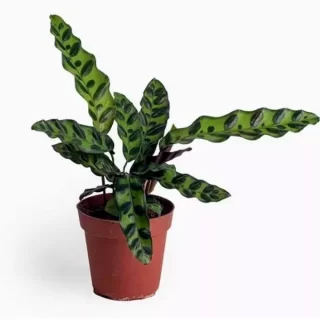
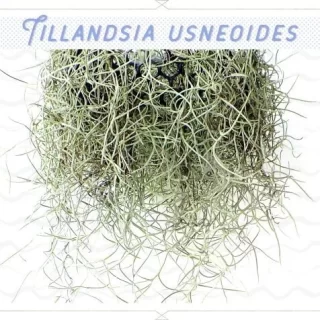
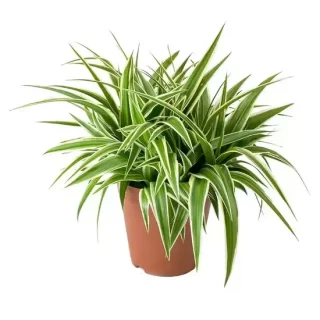
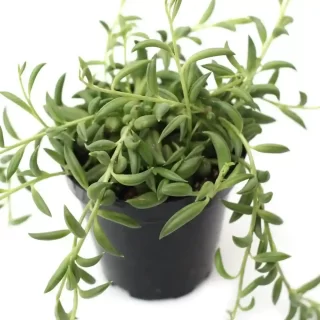
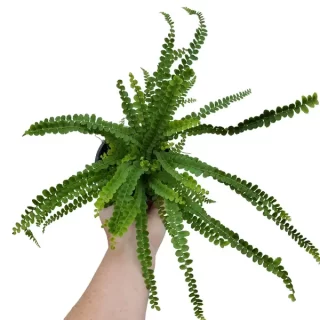
 If you need any assistance, I'm always here. Have you found what you were looking for?
If you need any assistance, I'm always here. Have you found what you were looking for?
Reviews
There are no reviews yet.